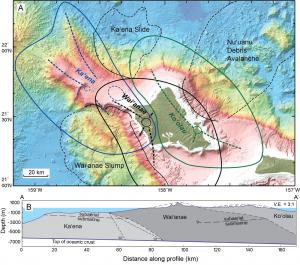Hawaii: Newly Discovered Underwater Volcano Ka'ena Rewrites Formation of O'ahu Island

A newly discovered underwater volcano shows that the Hawaiian island of O'ahu was formed by three major shield volcanoes, not two as was widely believed.
An international team of scientists led by the University of Hawai'i at Mānoa discovered a third volcano called Ka'ena, on whose flanks the Wai'anae and Ko'olau Volcanoes later formed.
Previously, it was thought O'ahu was the remnant of Wai'anae and Ko'olau. It was also believed that Wai'anae was exceptionally large and it formed a huge distance from its next oldest neighbour, a volcano called Kaua'i.
Lead author John Sinton said: "Both of these assumptions can now be revised: Wai'anae is not as large as previously thought and Ka'ena Volcano formed in the region between Kaua'i and Wai'anae."
The new volcano is located off the western tip of O'ahu in a large region called the submarine Ka'ena Ridge.
In 2010, scientists found unusual lavas from Wai'anae. Sinton explained: "We previously knew that they formed by partial melting of the crust beneath Wai'anae, but we didn't understand why they have the isotopic composition that they do.

"Now, we realise that the deep crust that melted under Waianae is actually part of the earlier Ka'ena Volcano."
Mapping of the seafloor in the region showed that the Ka'ena Ridge had an unusual structure, unlike submarine rift zone extensions of land volcanoes.
Data about the age, geochemistry and geological observations showed that Ka-ena was not part of Wai'anae, but was an earlier volcanic structure on which Wai'anae was built.
"What is particularly interesting is that Ka'ena appears to have had an unusually prolonged history as a submarine volcano, only breaching the ocean surface very late in its history," Sinton said.
Ka'ena is unusual because it is a Hawaiian volcano that formed in isolation deep on the ocean floor – most research of volcanoes in the area is based on those that rise high above sea level, and those that formed on the flanks of earlier ones.
Researchers have now collected rock samples from some of Ka-ena's shallowest peaks, with which they hope to establish the timing for the most recent activity from the volcano.
© Copyright IBTimes 2024. All rights reserved.







